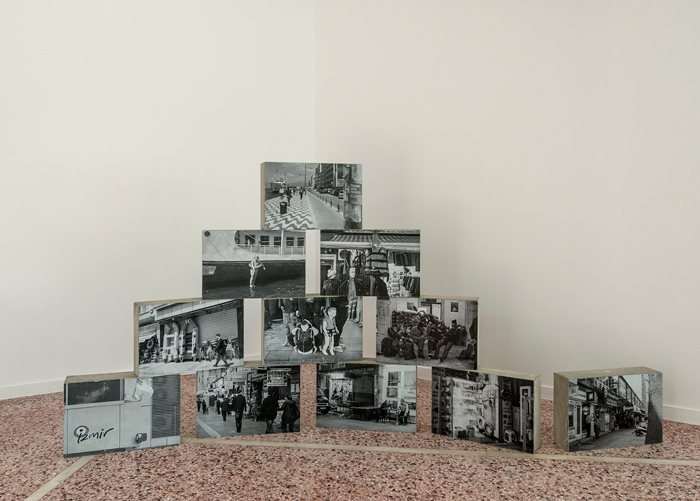Art Space Pythagorion, Samos, 5 August – 15 October 2016
Many will remember Ai Weiwei’s controversial stunt last January, when, freshly arrived on the Greek island of Lesbos, he published a photograph of himself posing as Alan Kurdi, the drowned Syrian boy who washed up on the Turkish shore a few months before. The widely circulated original photo of Kurdi’s death resulted in unprecedented financial and humanitarian support for those caught up in the European refugee crisis, but Ai’s provocative appropriation was seen by many as exploitative, a move to boost his international activist image.
Over on Samos, another Greek island that became a refugee ‘hotspot’ in 2015, A World Not Ours takes a significantly different stance. The curatorial statement points to the ‘opportunism’ of some artists, who ‘profess their engagement by producing facile one-liners and generating publicity for their own sake’. Featuring rather unusual suspects – six off-the-radar artists and a collective, two photojournalists and a group of designers, architects and statisticians – the show borrows its title from a brilliant 2012 documentary by Mahdi Fleifel (a personal and moving tale of life in a Palestinian refugee camp in southern Lebanon) and offers a more low-key and nuanced perspective on the migrant crisis.
There’s an emphasis on personal stories, starting with Marina Gioti’s intimate Agia Marina / Saint Marina (2016), a short film centred on an icon of Saint Marina, salvaged by the artist’s grandparents in their exodus from Greece during the Greco-Turkish War (1919–22). The conflict, which played out during the partitioning of the Ottoman Empire, caused forced deportations that resulted in one of the largest refugee population movements of the early twentieth century, a history that resonates fairly strongly with the situation on the island today. Elsewhere, activist and self-taught artist Sallie Latch presents sound recordings of interviews she made with refugees and volunteers during her time on the island, which feel more akin to documentary than to art. The stories are poignant, but the individual voices the recordings seek to highlight get lost in a milieu of ‘them’ from being played in a room that also features the work of Yannis Behrakis, a photojournalist who has been reporting on the crisis for Reuters over the past year. Projected as slides in the dark room, and in press clippings from print and online media in a vitrine display, the images seem all too familiar to the viewer, and their inclusion feels somehow like admitting a lack of confidence in art to address the issue.
Seductive in its minimalism and resourcefulness is Syrian-Hungarian artist Róza El-Hassan’s Adobe House (Samos) (2016), a cost-effective and ecofriendly igloo-shaped house inspired by traditional Syrian architecture, proposed in response to the refugee housing crisis (on my visit I was told more than once by volunteers that while Samos’s refugee camp was designed to house 700 people, more than 1,300 live there). El-Hassan, like many artists here, has been personally involved in the crisis through working with Syrian refugees, and these personal experiences lend an in-depth quality to the show. Another artist-activist is Austrian Tanja Boukal, who spent several months travelling between Samos and Turkey, retracing the steps of the refugees and underlining the industry that emerged from the crisis: Concrete Izmir (2016), a series of photographs taken in the streets of the Turkish city (and main crossing point to Greece) and printed onto concrete blocks, pictures displays outside tourist shops with mannequins sporting life vests and warm clothes, next to inflatable rafts and buoys.
The best work here, though, may well be Exit (2008–16), a data-visualisation chef-d’oeuvre by interdisciplinary design studio Diller Scofidio + Renfro in collaboration with architect-artist Laura Kurgan and statistician-artist Mark Hansen, as well as a core team of artists and scientists. Exit is a hypnotic 20-minute watch, featuring sequences of animated maps generated from multiple sources of data, and illustrat-ing the ins and outs of global migration and population displacement, that conveys a very real sense of urgency – one otherwise largely missing from the exhibition. While Ai Weiwei’s ‘raising awareness’ campaign may indeed feel opportunistic, without such punch, A World Not Ours unwittingly points to the limits of what art-as-activism can accomplish within the gallery space.
This article was first published in the October 2016 issue of ArtReview.
